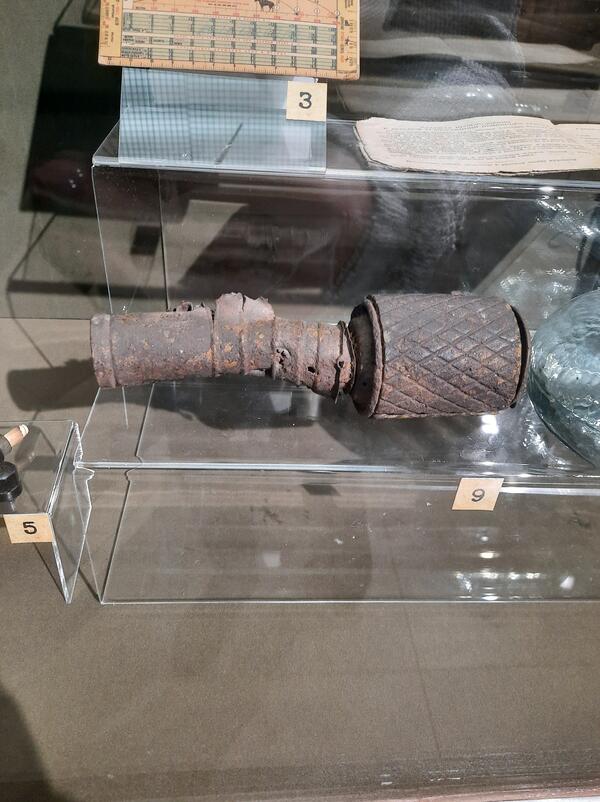During the Russian Civil War and thereafter, Red Army soldiers carried the Rdultovsky offensive grenade, known as the model 1914 grenade. It weighed only 700 grams and its shape was similar to a bottle which was convenient. It also featured a fairly reliable safety mechanism and was quite powerful. In 1930, the grenade was modernized and became widely used by Red Army units at the initial stage of World War II.
In 1933, the Soviet designer Mikhail Dyakonov invented the RGD-33 offensive (high-explosive) and defensive (fragmentation) grenade. This grenade had much in common in shape and design with the model 1914/1930, however, it was more powerful and its manufacturing processes were much more advanced. Its distinctive feature was the presence of a defensive sleeve (“a jacket”). The sleeve was fitted over the grenade for throwing it from sheltered positions, which increased the radius of dispersed fragments from 25 meters to 100 meters, and their effective kill radius — from 5 meters to 25 meters. When the grenade with the “jacket” exploded, up to 2,400 fragments were formed.
The RGD-33 grenade had a tin body in which the explosive charge was placed. The handle was manufactured and stored separately. Inside it had an assembled trigger mechanism that ignited the fuse. The fuse was stored separately. When grenades were to be given to soldiers, the handle was screwed onto the body.
When the handle was screwed onto the central tube of the grenade body, the inner tube of the handle was attached to it in such a way that the handle was fixed (a locking mechanism did not allow the handle to unscrew). The outer tube of the handle could be pulled back and rotated to the right and left. It was fastened to the inner tube only by a locking spring and a bracket that slid along the grooves of the inner tube.
The assembled grenade was kept in a grenade pouch. The fuse was stored separately in a box. The percussion fuse was ignited only if the grenade was thrown. If a loaded and ready for throwing grenade accidentally fell out of a soldier’s hands, it did not detonate (even if the safety pin was pushed aside). It could be picked up and thrown again. Hence, it was convenient and safe to use.
Several million RGD-33 grenades were manufactured and used at the initial stage of the war. To destroy tanks, three or five grenades were tied together with twine or wire so that the handle of the grenade in the center was pointed in one direction, and the two other handles — in the opposite direction.
In 1933, the Soviet designer Mikhail Dyakonov invented the RGD-33 offensive (high-explosive) and defensive (fragmentation) grenade. This grenade had much in common in shape and design with the model 1914/1930, however, it was more powerful and its manufacturing processes were much more advanced. Its distinctive feature was the presence of a defensive sleeve (“a jacket”). The sleeve was fitted over the grenade for throwing it from sheltered positions, which increased the radius of dispersed fragments from 25 meters to 100 meters, and their effective kill radius — from 5 meters to 25 meters. When the grenade with the “jacket” exploded, up to 2,400 fragments were formed.
The RGD-33 grenade had a tin body in which the explosive charge was placed. The handle was manufactured and stored separately. Inside it had an assembled trigger mechanism that ignited the fuse. The fuse was stored separately. When grenades were to be given to soldiers, the handle was screwed onto the body.
When the handle was screwed onto the central tube of the grenade body, the inner tube of the handle was attached to it in such a way that the handle was fixed (a locking mechanism did not allow the handle to unscrew). The outer tube of the handle could be pulled back and rotated to the right and left. It was fastened to the inner tube only by a locking spring and a bracket that slid along the grooves of the inner tube.
The assembled grenade was kept in a grenade pouch. The fuse was stored separately in a box. The percussion fuse was ignited only if the grenade was thrown. If a loaded and ready for throwing grenade accidentally fell out of a soldier’s hands, it did not detonate (even if the safety pin was pushed aside). It could be picked up and thrown again. Hence, it was convenient and safe to use.
Several million RGD-33 grenades were manufactured and used at the initial stage of the war. To destroy tanks, three or five grenades were tied together with twine or wire so that the handle of the grenade in the center was pointed in one direction, and the two other handles — in the opposite direction.





